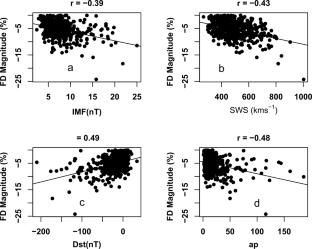Low-magnitude (FD(%) \(\geq -3\%\)) Forbush decreases (FDs) and their space weather linkages are recently becoming popular in the literature. Accurate timing and correct magnitude measurement of weak FDs are a desideratum. This demands disentangling the effects of the ever present cosmic ray (CR) diurnal wave that exerts undesirable influence on CR data. An enhanced version of a recently developed algorithm has been deployed to decompose raw CR data at Apatity (APTY) and Moscow (MOSC) neutron monitor (NM) stations into low and high frequency signals. A subroutine in the Fast Fourier transform software simultaneously calculates the magnitude and the epoch time of the events from the transformed data. The software selected 335 and 359 low magnitude FDs respectively for APTY and MOSC observatories. The large catalogues of low-amplitude FDs selected compared to those in literature may be attributed to the efficiency of the present algorithm. We carried out a regression analysis on the magnitude of these events and the corresponding solar wind disturbance agents. The analysis shows that for the APTY NM station, the correlation coefficient results \(r\) for FD-interplanetary magnetic field (IMF) and FD-planetary geomagnetic activity index (ap) relations are statistically significant at 95% confidence level. At the MOSC station, we find \(r\) ∼ −0.41 statistically significant at 95% confidence level for FD-solar wind speed (SWS) relation (after removing events due to co-rotating interaction regions). Analyzing all (low- and high-amplitude) FDs, \(r\) is relatively strong and statistically significant at 95% confidence level. The implications of these findings are discussed.




